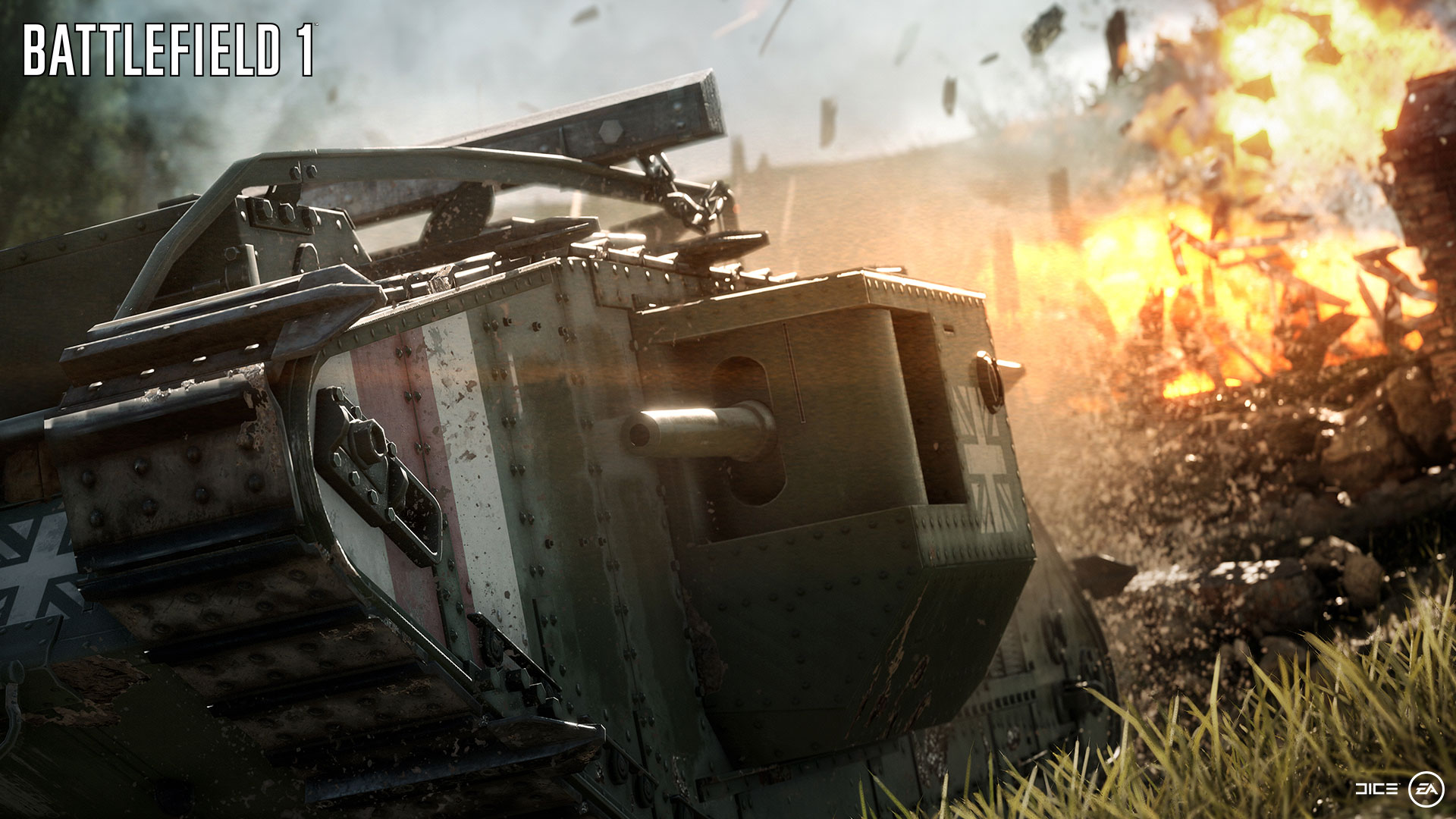Up go the signal flares, the shouts, the tracers and plumes of artillery smoke, the embers from blazing trees like startled fireflies. Out go the soldiers in tin hats, the bayonets, the haversacks and hobnailed ankle boots. Down rains devastation, hundreds of pounds of steel-cased explosives flung in parabolic arcs from smooth-bored cylinders. Above it all, a study in contrasts: half the dimming blues of an idyllic sunset, half atomic wrack and bloom, like the skies over Mordor.
I’m taking the view off Cape Helles near Gallipoli circa 1915, beside the deck rail of a ship flanked by Dreadnoughts, about to charge the beachhead. Uphill lies cragged headland, machine gun roosts, bulwarks of stacked logs and the terra-cotta rooftops of a village below a crumbling fortress. I could linger indefinitely, the moment frozen in motion like the looping images in a Harry Potter tabloid. It’s a scene from DICE’s Battlefield 1, a stupefyingly gorgeous first-person shooter out for PC, PlayStation 4 and Xbox One on October 18 that puts the lie to decades of assumptions—that World War I’s internecine trench volleys and wire-snarled footslogs are anathema to gameplay anyone might find tactically absorbing.
Here are doting replicas of weapons a dwindling few in 2016 will know: Mausers and Lee-Enfields, Hotchkiss M1914s and Bergmann MP 18s, trundling Mark V tanks, buzzing Fokker Dr.I triplanes and L 30 airships almost as long as a pair of football fields. The latter look like something out of an alt-history yarn, but they’re not—these madcap, sky-blotting death balloons really existed. The arsenal feels diverse, too, a trove of gadgets and gas masks, landships and light vehicles gradually encountered in solo or online play. Each feels familiar but functionally antecedent, the brutalizing implements of an era in which the apocalyptic thresholds of global brinksmanship had yet to be charted.

Juxtaposed with photos, Battlefield 1‘s weapons are virtual analogues of their archetypes, though having hefted none in real life, all I can tell you is that wielding them efficiently requires adaptation to slower fire and reload rates. That, scant battlefield ammunition and fully destructible environments reward more cautious, methodical gunplay that’s nothing like the boisterous lethality on casual loan in so many modern shooters. DICE could have skinned a bunch of contemporary weapons to resemble The Great War’s bolt-action rifles and snail drum SMGs and called it a day. Instead, they’ve embraced the early 20th century’s technological idiosyncrasies, finessing everything just enough to keep it all as brisk and ballistically persuasive as anything with homing rockets or a laser sight.
The game acquaints you with most of this by guiding you through a solo campaign that’s divvied into standalone “war stories.” The stories march you through quasi-linear maps linked to historical battles that transpired in French countrysides, the Italian alps and southern Levant. All of this is naturally rendered at DICE’s habitual overachiever levels of visual insanity. And if you’re a PC gamer rocking an ultra-HD television with high-dynamic range, the views are gobsmacking.
Each story offers a unique problem or narrative perspective: a bickering tank crew lost behind enemy lines during the Battle of Cambrai, the latent heroism of a cocksure swindler-turned-aviator amidst “Bloody April,” the remembrances of an Italian war vet relayed to his daughter during a birthday party. All told, they add up to perhaps a half-dozen hours of play, but offer some of DICE’s finest work—an attempt to get around the usual boo-rahs or faux gravitas by bracketing eruptions of carnage with humanizing, anthology-style accounts. I only wish they’d made more.

But like any other Battlefield, multiplayer is where you’ll eventually entrench, obsessing over soldierly performance statistics and unlockables once you’ve cleared the campaign and rounded up its collectibles. Most of the online modes we’ve seen, from Conquest’s 64 players jockeying to hold objectives across prodigious battlegrounds, to Domination’s close-quarters infantry skirmishes. Of the new modes, the easy keeper is Operations, a smart rethink of Conquest’s all out land-sea-air battles that gathers multiple maps into sprawling, round-based tug-of-wars framed by historical scenarios.
Here Battlefield 1‘s less precise weaponry and slower-moving vehicles work to the game’s advantage, modulating the havoc of platoon-scale fracas by increasing reaction times and slowing things down in general. It won’t protect neophytes from practiced adepts who’ve mastered every weapon’s quirks and committed all of a map’s exploit points to memory. But it does scale back the sense that you’re playing a game in which the outcomes feel pathologically precision-driven.
No, this isn’t what you’ll want to point to when highlighting games that have something to say about the horrors of war (for examples of those, see This War of Mine or Valiant Hearts). Even Battlefield 1‘s war stories, once you’ve left a cutscene’s moorings to push buttons or nudge thumb-sticks, have at best the emotional insight and depth of a Fast & Furious flick. Latitudes stand between the game’s slick, chaperoned vignettes and online free-for-alls, and something like Wilfred Owen’s “Dulce et Decorum Est” or Hemingway’s A Farewell or Arms.
Which is just to say Battlefield 1 (buy here) isn’t interested in adding ruminative ballast. Given what it’s so deftly up to (or, if you will, not up to), there’s nothing shameful in that.
4.5 out of 5
Reviewed on PC
More Must-Reads from TIME
- Why Trump’s Message Worked on Latino Men
- What Trump’s Win Could Mean for Housing
- The 100 Must-Read Books of 2024
- Sleep Doctors Share the 1 Tip That’s Changed Their Lives
- Column: Let’s Bring Back Romance
- What It’s Like to Have Long COVID As a Kid
- FX’s Say Nothing Is the Must-Watch Political Thriller of 2024
- Merle Bombardieri Is Helping People Make the Baby Decision
Write to Matt Peckham at matt.peckham@time.com